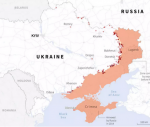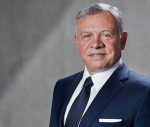You are here
Stuck in Area A
Apr 21,2015 - Last updated at Apr 21,2015
Are you surprised that there has been little mobilisation to help Yarmouk, the Palestinian refugee camp on the outskirts of Damascus, which is overrun by militants, and besieged by the Syrian army?
Palestinians — and Syrians — there are killed in many ways, including starvation.
I am not surprised.
Even before Palestinian refugees found themselves embroiled in Syria’s conflict, I appealed to all parties involved, including the Palestinian leaderships (alas, there are several) to spare the refugees the burden of war, and for Palestinians to set their differences aside to avoid a repeat of Lebanon, Kuwait and Iraq.
Nothing happened, as if recent history were of no consequence and offered no lesson.
Hamas was stuck in Gaza, in both real and figurative sense: its attempt at regional politicking was, and is, a failure, and it is reeling under siege.
Mahmoud Abbas, his Palestinian Authority and whatever branch of his Fateh Party currently at the helm is stuck in his Area A — a supposedly self-governed region that constitutes about 3 per cent of the West Bank.
While the Israeli army can still raid Area A, made mostly of densely populated cities — arresting Palestinians at will — Abbas is entrusted with managing the affairs of the Palestinians there, which should have been an Israeli responsibility as an occupying power, under the Geneva Conventions.
Area B, which is under joint Israeli PA security control, constitutes about 23-25 per cent of the West Bank and is composed mostly of thousands of Palestinian villages that are virtually under Israeli control.
But a whopping 72 per cent of the West Bank is under Israeli control. That is where settlements are mostly located and the Israeli military rules with an iron fist.
While Israel sees the entirety of Palestine as its geographic domain and the whole Middle East region as its political and security sphere, Abbas is stuck in Area A, which is less than 1 per cent of the total size of historic Palestine.
Area A is his bread and butter, his reason for existence as a “president” ruling over a population trapped by Israeli walls and checkpoints, Israeli-PA security coordination and the humiliating need for a paycheque at the end of each month.
But while many of us were focused on discrediting Oslo and its defeatist culture, we, too, are stuck in Area A.
We cannot break free from reducing Palestine and the Palestinian people and millions of Palestinian refugees to Area A.
We do not do this out of malice, or because we do not care about Yarmouk in Syria, Ain Al Hilweh in Lebanon or Baladiat in Iraq.
As we laboured to discredit Oslo, we had no unifying vision outside the confines of Oslo, trapped in its disempowering language and impossible geography.
There is much history behind this and I will not go into its details. But an incident that took place over 10 years registered deeply in my mind.
I was working then for a human rights NGO in London. A man with a distraught voice called our office.
“Help me, for Allah’s stake, please help me,” he cried.
He was literally weeping.
My attempt to comfort him failed. He called me using a borrowed cell phone from a rights worker at a refugee camp between Iraq and Jordan. His two brothers were murdered in the Palestinian Baladiat neighbourhood in Baghdad, one by the Shiite militias, one by the Americans.
His attempt to seek safety in Jordan was unsuccessful. Palestinian refugees have strange status, irrelevant travel documents that make it extremely hard to travel.
His papers were the wrong kind. He spent many months in the desert camp. I tried, but could do nothing for him.
His problem, like that of the Yarmouk refugees, is that he fell out of favour with politics, with geography, with any applicable human rights.
As if he fell out of favour with life altogether.
The only relevant document was the Right of Return for Palestinian refugees enshrined in UN Resolution 194, a document cited generously by researchers and activists, but that carries no actual weight, not for the refugees of Baladiat — hundreds of them perished in the US invasion — and not for the 18,000 refugees who remain trapped in Damascus.
The process of fragmenting Palestine is as old as the conflict and has been dictated largely by Israel; many of us, including Israel’s detractors, followed suit, unknowing that we are contributing to the very process that meant to marginalise numerous Palestinian communities.
When Israel occupied East Jerusalem, the West Bank and Gaza, we spoke of “Palestinian territories” not Palestine.
Progressively, Palestinians who are citizens of Israel were dropped from the Palestinian and Arab political discourse, as if they ceased being Palestinian.
When Oslo was signed, we borrowed its despairing terminologies and confusing geography of areas A, B and C.
We often learn about the existence of Palestinian villages that happened to fall in the way of the Israeli separation — read apartheid — wall, simply because they fell in the way of the Israeli bulldozers defacing Palestinians land.
We speak of Gaza when Israel bombs Gaza. In fact, Gaza became central to the Palestine discourse just after the Israeli siege in 2007. Prior to that, it was an addendum in a political language centred mostly on the West Bank, primarily in Ramallah, the seat of the throne of Area A.
We are trapped in Israeli definitions. Thus, when Palestinians are starved, beheaded or blown to smithereens in Yarmouk, we stand puzzled.
We offer sympathy, tears and little action. We cannot even articulate a coherent discourse, aside from pulling out UN Resolution 194 from some dusty archive to talk about the “right of return” and how the suffering in Yarmouk is ultimately Israel’s responsibility.
Proud by our efforts, we carry on with life as if we saved the refugees, all at once, with a single link to a UN website.
When Israel carried out its war on Gaza last summer, nearly 150,000 people protested in London in another massive show of solidarity, duplicated in many cities across the world.
For Yarmouk, about 40 people showed up, an admirable effort, but expressive of the fact that the refugees no longer are at the heart of the Palestine discourse.
In the constant attempt at exposing Israeli injustices against Palestinians, most of us were duped into an Israeli-PA attempt at reducing Palestine to a tiny speck of its actual physical and political spaces that extends from Palestine — the entirety of Palestine — across the Middle East, hovering above Yarmouk, as it has for many years, without us noticing.
We are trapped in Area A, making an occasional crossover to areas B and C, only to get back to Area A, where it is relatively safe and things easy to fathom and explain.
We are stuck behind Israeli walls and checkpoints as we are failing to see the massive space that is Palestine, and the millions of refugees still holding on tattered deeds and rusty keys, since we promised that that their right of return is paramount.
Did we lie? Were we lied to?
It is more likely that we were duped into a pseudo-reality crafted proficiently by Israel and we are finding it extremely difficult to break away from its confines.
But if our hate for the Israeli occupation, and our loathing of Israeli policies are greater than our love for the Palestinians, all of them, starting with the refugees dying in Yarmouk, then, perhaps, it is time to reconsider our understanding and relationship with the conflict altogether.
The writer, www.ramzybaroud.net, is an internationally syndicated columnist, a media consultant, author of several books and the founder of PalestineChronicle.com. His latest book is “My Father Was a Freedom Fighter: Gaza’s Untold Story” (Pluto Press, London). He contributed this article to The Jordan Times.













